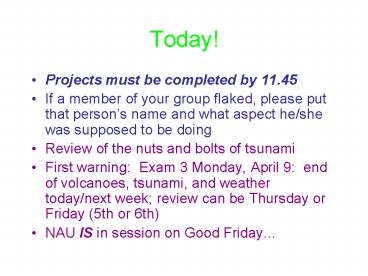Today! PowerPoint PPT Presentation
Title: Today!
1
Today!
- Projects must be completed by 11.45
- If a member of your group flaked, please put that
persons name and what aspect he/she was supposed
to be doing - Review of the nuts and bolts of tsunami
- First warning Exam 3 Monday, April 9 end of
volcanoes, tsunami, and weather today/next week
review can be Thursday or Friday (5th or 6th) - NAU IS in session on Good Friday
2
Consider this picture of a normal sea wave
D
A
C
B
3
Which of A, B, C, D is the trough of the wave?
D
A
C
B
4
Which of A, B, C, D would be used to measure the
height of the wave?
D
A
C
B
5
Which of A, B, C, D would be used to measure the
wavelength?
D
A
C
B
6
The period of a tsunami
- is shorter than the period of a wind wave
- means the speed of the wave
- can be hours
7
One major difference between a normal (wind)
ocean wave and a tsunami wave is
- A wind wave moves faster
- A tsunami wave moves in a rolling, circular
motion - A tsunami wave is generally more easy to feel for
a boat at sea - A tsunami wave can be much higher
8
Hazardous weather/ tornadoes/hurricanes
- READ for Monday
- chapter 7 start at 7.2, read also 7.3 7.4
- be ready for a quiz that may ask for your
understanding of humidity, what the parts of the
atmosphere are that affect weather, where the
ozone layer is, air pressure, and what kind(s) of
cloud(s) is/are common to the thunderstorms we
have on the Colorado Plateau - read ahead if you are motivated! -- sec. 7.5
9
Something you should know
- Elevation height about sea level. We live at
(about) 7000 elevation, or (about) 2100 m - Altitude height above the ground. Your nose is
at an altitude of about 5, most clouds form at
an altitude less than about 15 km (10 miles)
10
weather
- heat in the planets water
- heat in the planets air
- movement of water (ocean currents) and air
11
atmosphere
- envelope of gas that surrounds the earth
- gas molecules, mostly N and O2
- particles of liquids and solids
Our atmosphere N and O2
Marss atmosphere CO2 and little else
12
atmosphere
- 450 km thick, or 100 km, or 50 km, depends on
what you call atmosphere -- eventually it becomes
space -- but 80 is less than about 15 km (10
miles)
13
humidity
- air holds water warm air holds more water than
cold warm air is always more humid than cold
air - we have polar ice caps because warm air rises
from tropical water, full of moisture, and falls
at the N and S poles, losing all that moisture
14
Atmospheric pressure (high and low pressure)
- weight of the air over a specific place on earth
- changes with altitude
fewer gas molecules in the atmosphere at higher
elevation lower pressure
lots of gas molecules in the atmosphere at low
elevation higher pressure
15
Atmospheric pressure (high and low pressure)
- weight of the air over a specific place on earth
- changes from place to place -- areas of high (air
falls) and low (air rises) pressure - rising air loses moisture (forms clouds and
rain/snow) - falling air has little/no moisture -- clear skies
- high and low pressure have no relation to
temperature
16
Rain shadow
17
very quick clicker question
18
which way does the earth rotate?
- east to west
- west to east
- north to south
- south to north
19
the Coriolis effect moving air around the planet
a stationary planet with no rotation
- clouds watch the earth rotate beneath them
- if the planet didnt rotate, air masses would
move directly N/S or from high to low pressure
20
the Coriolis effect moving air around the planet
a planet that rotates
- because the earth rotates, from WEST to EAST,
wherever the air mass thought it should be going,
its now a bit farther west - importance air (clouds) go from ____ pressure
to ____ pressure, but cant get there in a
straight line

